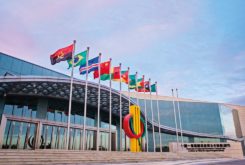Angola’s President João Lourenço has put reinvigorating the agriculture sector at the heart of his economic strategy. Greater production of a wider range of crops would both reduce the US$3 billion a year that the country spends on food imports and also improve living standards in the rural areas that have missed out on more rapid economic development at the coast.
Lourenço predicts that the country will be close to food self-sufficiency by the end of his first term of office. This is an optimistic timetable but an important goal. The country wasself sufficient in most staple crops prior to independence and was a significant sugar and coffee exporter. At present, about 80% of all Angolan food production comes from subsistence agriculture and very small scale farming, so there is huge scope for much greater production.
There has already been some progress, as the sector accounted for 12% of GDP in 2017, up from 8% in 2001. However, increased production mainly seems to have been the result of increasing the proportion of land under cultivation rather than higher productivity. The former has partly been achieved by returning land to agricultural use after the civil war, although even now most potential arable land lies unused.
Lourenço has promised to increase the proportion of the budget allocated to agriculture from 0.3% in 2018 to 1.6% this year, with most support directed at small-scale farmers. A total of 179.4 billion kwanzas (US$565 million) will be available for agricultural support this year. Six research centres are being set up in different parts of the country, each with responsibility for specific crops. For instance, the Huambo centre will focus on beans, corn and soya, while Kwanza Sul will specialise in cocoa, coffee and palm oil.
The President has listed import substitution in food production as one of his main priorities under the Production Support Programme: Diversification of Import Export and Replacement (Prodesi). It remains to be seen whether this will involve placing duties on food imports to encourage local production, but given that a lot of imported food is very expensive this may not be necessary.
Staple crops
The national director of agriculture, José Carlos Bettencourt, said in December that there was huge potential for foreign and domestic companies to invest in cultivating the staple foodstuffs that are currently mainly imported.The country still imports a large proportion of its rice and cooking oil requirements, despite the fact that several provinces have attractive conditions for the cultivation of rice, soya beans and sunflower seeds.
Angola produced just 63,000 tonnes of rice in 2017 but consumed 400,000 tonnes. Similarly, it produced just 30 tonnes of soya in the same year but consumed 240,000 tonnes.Finally, the government is keen to boost the production of legumes, including beans. Angola currently produces about 350,000 tons a year but again this is a long way short of its potential.
According to the Ministry of Agriculture and Forestry, the country is already self sufficient in bananas and pineapples, and has the potential to become self sufficient in mangoes, maize and beans in the near future because large areas have attractive soil and climatic conditions for their cultivation. There has been a lot of progress in some sectors. Angola produced 2.68 million tonnes of maize in 2017, up from just 526,000 tonnes in 2006, although annual consumption stands at about 5 million tonnes, so much more is needed.Huila accounts for about half of national maize production but even there more maize could be cultivated.
Luanda is keen to ensure that existing projects are developed as planned. China Development Bank helped to finance the integrated Manquete agribusiness project in Cunene Province focused on rice and maize cultivation on 1,500 hectares of land, but work was halted in May 2017. Control of the project, which includes three 1,000 ton silos – two for rice and one for corn, has now been transferred to Faz Angola. All production can be dehusked, cleaned and packaged on site.
Climate change
Aside from promoting economic development, creating a stronger agriculture sector will help to promote food security. An estimated 1.1 million Angolans in Cunene, Huíla and Namibe provinces were affected by drought in the first quarter of this year. The Food Resilience and Nutrition Security Programme in Angola (FRESAN) attributed the problem to climate change.In 2018, FRESAN signed a €65 million agreement with the European Union to mitigate the impact of drought on the rural population of Angola. Part of the money will fund research into the best methods of adapting agriculture to climate change.
FRESAN coordinator Matteo Tonini said: “The situation is particularly worrying if we take into account climate models for the coming years, which provide for seasonal changes in the precipitation regime, increased frequency and intensity of extreme weather events, expansion of arid and semi-arid regions and an increase in air temperature and of the sea.”
One of the biggest obstacles to higher agricultural production is the lack of a local supply chain for tools, seeds and fertilisers. Most agricultural inputs have to be imported, driving up costs. However, in February, the Minister of Agriculture and Forestry, Marcos Nhunga, announced that a factory to produce ploughs, hoes and machetes, and another for tractors, would soon be built, although he did not reveal their respective locations.
It seems likely that the tractor plant will not open in the near future, given that the government plans to import 900 tractors, probably this year and next.The tractors are being supplied under an agreement withthe Ministry of Agriculture and Forestry and the government of South Korea and will replace outdated vehicles owned by the National Agricultural Mechanization Company.
The census
Government efforts to boost the sector have been hampered by the lack of hard data on the size and nature of existing operations. However, the World Bank has agreed to provide a US$24.9 million loan to enable the National Statistic Institute (INE) to fund a national farming census.The results should prove very useful in terms of planning sector support, research projects and veterinarian services.
The head of INE enquiry and census department, Paulo Fonseca, said that a pilot study will be undertaken in the first instance in the provinces of Moxico, Uíge, Cuanza Sul, Benguela and Cunene between February and December this year. They have been chosen because of the dense distribution of farms in those provinces.
While the IMF is keen for Angola and many other African countries to reduce subsidies on consumption, Luanda has announced that it will introduce fuel and fertiliser subsidies for farmers. It is hoped that this will reduce retail fertiliser prices by up to 25% and fuel costs by 20-25%.
Chinese support
Angolan and Chinese officials hope that Angola can begin exporting more agricultural products to China, including cassava flour and fruit juice. Sino-Angolan bilateral trade was worth US$26 billion in 2018 but this was dominated by Angolan oil exports. Chinese support for Angolan agriculture focused on infrastructural investment prior to 2008 but since then China Development Bankhas switched its support to farm projects. In a speech in Soyo City in February, the Chinese ambassador to Angola, Cui Aimin, said that the Chinese government would finance various initiatives aimed at supporting the development of the Angolan agriculture sector.
The governments of China and Angola signed a bilateral cooperation agreement in Beijing in October, including a new US$2 billion credit line for the Angolan government. Some of this money will be made available to agricultural projects, including a US$13 million tranche in January alone. Various Chinese institutions already organise agricultural and agribusiness training courses in Angola. For instance, the Agricultural and Livestock Faculty of Jiangzhou ran a two week course for 40 employees from the Angolan Agrarian Development Institute and Huambo Province farmers in November.
A range of multilateral organisations have provided support for Angolan agriculture. The International Fund for Agricultural Development has contributed US$28.8 million of the US$38.2 million needed to support the development of family farms with less than two hectares of land in Huíla and Cuanza Sulprovinces, under a seven year programme that started in 2018. The Angolan government is providing most of the remainder. Training courses, including in irrigation, are being provided to ten thousand people.
The government is keen to encourage agricultural diversification by supporting the cultivation of crops that have never or rarely been cultivated in Angola and there are already signs that the policy is succeeding in some areas. To take one example, coffee in the municipality of Caluquembe in Huíla increased from seven tonnes in 2017 to 15 tonnes last year and the planting of 25,000 more coffee trees should see output continue to climb over the next few years.
Eliseu José, the director of Agriculture, Livestock and Fisheries in the province, said that it was difficult to predict future production levels. He added: “We cannot plan the harvest because we are going to start planting, monitoring the state of the plants; because there are some that die, others that do not produce; and only after assessing the situation, can we give a forecast.” (CLBrief)



